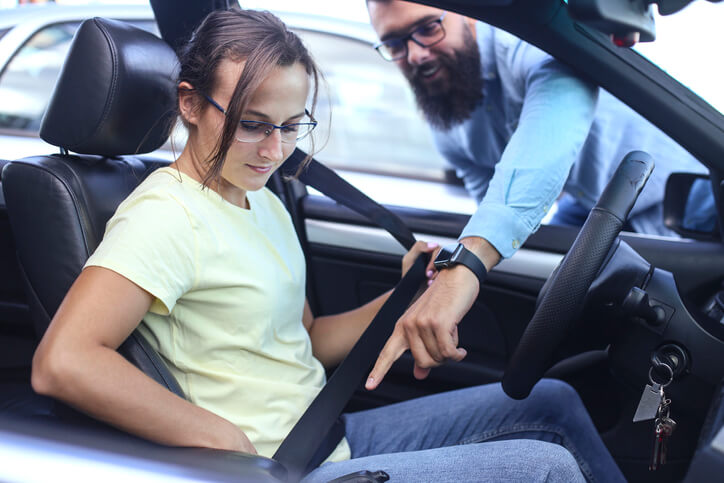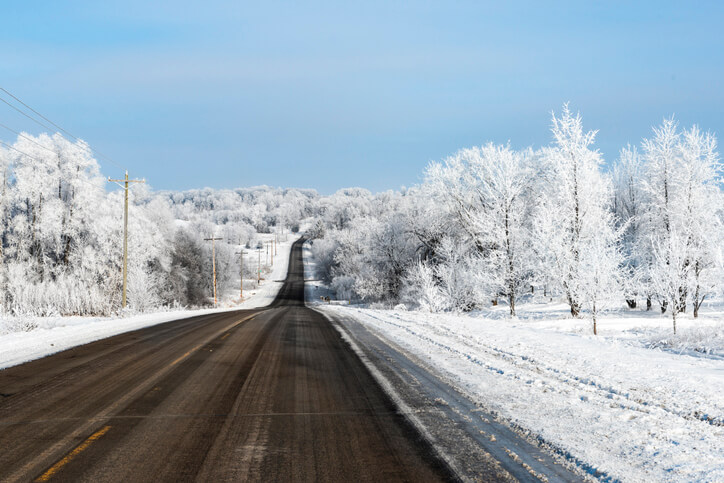Embarking on the adventure of driving in Wisconsin can be both thrilling and challenging. With its diverse landscapes, varying weather conditions, and unique traffic regulations, it’s essential to have a solid understanding of Wisconsin driving laws to ensure a safe and enjoyable experience on the road. This blog post aims to provide a comprehensive guide to the essential rules and regulations for motorists in Wisconsin, empowering you to navigate the state’s roads confidently and responsibly.
Wisconsin Driving At a Glance
- Understand Wisconsin speed limits and traffic signals/signs to promote road safety.
- Adhere to car seat laws, winter driving regulations, and DUI laws for a safe driving experience.
- Be aware of penalties for violating traffic rules to protect your privileges as a driver.
Understanding Wisconsin Speed Limits
Wisconsin’s speed limits are designed with the unique characteristics of each area in mind, protecting all road users. Observing and adhering to these appropriate speed limits is key to securing a safe and efficient driving experience.
We will examine the different speed limits in Wisconsin and their applicability to various road situations.
Highway and Interstate Speeds
Higher speed limits are generally found on highways and interstates in Wisconsin, allowing for faster travel between destinations. On rural freeways, the maximum speed limit for automobiles is 70 mph, while on urban freeways, it is 65 mph. Remember that during cold winters, road conditions may change, requiring drivers to adjust their speed accordingly to maintain safety.
Always adhere to the posted speed limits and be ready to make any necessary adjustments due to changing driving conditions.
School Zone Safety Speed Regulations
The safety of children is of utmost importance when driving near schools, and Wisconsin has specific speed regulations to ensure their protection. In school zones, the speed limit is typically 15 mph, and this reduced limit is in effect when a child or crossing guard is present. Failing to obey school zone speed limits can result in fines ranging from $30 to $300, so it’s vital to remain vigilant and cautious around school buses and in school zones.
Residential and Urban Speed Limits
Wisconsin’s residential and urban speed limits are set to ensure the safety and well-being of pedestrians, cyclists, and other road users. The customary speed limit is 25 mph in both residential and urban areas. These lower speed limits help prevent accidents and make communities safer for everyone.
Always follow the posted speed limits and be prepared to adjust your speed based on the specific driving conditions you encounter.
Mastering Wisconsin Traffic Signals and Signs
Traffic signals and signs in Wisconsin are vital in maintaining road order and safety for all users. Understanding and adhering to these signals, red light rules and four-way stop procedures can help prevent accidents and maintain smooth traffic flow.
Now, let’s examine these important traffic regulations more thoroughly.
Understanding Red Light Rules
Red light rules in Wisconsin are designed to regulate traffic flow and keep intersections safe. Generally, drivers are allowed to make a right turn at a red light unless a “no turn” sign is posted at the intersection. However, there are exceptions to these rules, such as for bicyclists who may be allowed to proceed through a red light under specific conditions.
Disregarding a red light can result in a fine of $98.80 and adding three points to your driving record.
Navigating Four-Way Stops
Four-way stops in Wisconsin require drivers to understand and follow right-of-way rules and proper yielding techniques. All drivers must come to a complete stop at a four-way stop before proceeding. The driver who arrives first has the right of way and may move first, while the driver to the left must yield the right of way and remain stationary until the other driver has departed.
Failure to yield the right of way at a four-way stop, or making an illegal U-turn, can result in penalties, such as fines and points on your driving record.
Keeping a Clean Driving Record: Demerit Points and Violations
Maintaining a clean driving record is key to preserving your driving privileges and keeping insurance rates low. Wisconsin operates a demerit points system to monitor traffic violations and penalize habitual lawbreakers. Comprehending the points attributed to common violations and the repercussions of point accumulation can help avoid fines, license suspension, and other penalties.
Points Assessed for Common Violations
Points assessed for common violations in Wisconsin can significantly impact your driving record and insurance rates. For example:
- Speeding violations of 20 miles per hour or more above the speed limit result in six demerit points.
- Running a red light accrues four points.
- Reckless driving adds six points to your record.
Knowing these points and adhering to traffic laws can help you maintain a clean driving record and avoid costly penalties.
Consequences of Accumulating Points
Accumulating points on your driving record in Wisconsin can lead to severe consequences, such as fines, license suspension, and mandatory traffic safety courses. If you accumulate 12 or more points within 12 months, your license will be suspended for at least two months.
To avoid these consequences, you’ll want to familiarize yourself with traffic laws and always practice safe driving habits.
Navigating Known Problem Intersections an Roadways in Wisconsin
Navigating Wisconsin’s roads can pose challenges, particularly at known problem intersections and roadways. These areas demand additional caution and awareness from drivers to avoid accidents and guarantee a safe driving experience.
Let’s study some of the unique challenges drivers face in the Badger State, and how to handle these situations safely.
Difficult Intersections in Wisconsin
- W Capitol Drive and W Fond Du Lac Avenue: This is a hotspot for collisions, including those hit-and-runs. Key tip? Stay alert to traffic signals and watch out for sudden stops or pedestrians.
- N 27th Street and W Center Street: Another dangerous intersection with its share of collisions. It’s always a good idea to yield if someone’s already in the intersection, even if you have the right of way.
- N 35th Street and West Capitol Drive: Keep distractions to a minimum – focus on the road, traffic signs and signals, and any pedestrians in the area—good advice for any intersection.
- N 27th Street and W Fond du Lac Avenue: A top spot for dangerous collisions. Extra caution is needed for cyclists and pedestrians around here.
- N 51st Boulevard and W Capitol Drive: Keep a safe following distance, especially during winter. Wisconsin’s winter weather can wreak havoc here.
Wisconsin’s Risky Roads:
- SR-190 in Milwaukee: This is a challenging stretch between SR-100 and W Hopkins Street. Maintaining your vehicle is always essential, but you’ll really appreciate functional brakes, lights, and signals on this stretch.
- SR-59 in Milwaukee: This road from S 1st St to S 76th St sees its fair share of collisions. Signal your turns to communicate with other drivers.
- US-51 in Madison: The stretch from Anderson Rd to SR-30 can be tricky. Avoid sudden lane changes and always signal.
- I-90 in Janesville: Be extra cautious between exits 171B and 177. Avoid blocking intersections and stay ready to stop.
- I-94 in Milwaukee: Be mindful of your surroundings between exits 305A and 310B.
Wisconsin's Approach to Distracted Driving
Distracted driving significantly threatens the safety of all Wisconsin road users. In response to this problem, the state has enforced strict restrictions on cell phone usage, texting while driving, and penalties for rule violations.
We will analyze Wisconsin’s approach to distracted driving and the specific restrictions introduced to promote safer roads.
Cell Phone and Texting Restrictions
In Wisconsin, cell phone and texting restrictions aim to reduce accidents caused by distracted driving. Using a handheld or hands-free cell phone while driving is illegal if you have a probationary license. Additionally, all drivers are prohibited from texting while driving, including writing or sending electronic text or mail messages.
Adhering to these restrictions can help you stay focused on the road and minimize the risk of accidents caused by distractions.
Penalties for Distracted Driving
Penalties for distracted driving in Wisconsin include fines, demerit points, and potential license suspension. Penalties for distracted driving range from $20 to $400 and four demerit points are added to your driving record for inattentive driving.
By following Wisconsin’s driving rules and avoiding distractions behind the wheel, you can keep yourself and others safe on the road.
Child Passenger Safety: Car Seats and Booster Seat Laws
Safeguarding child passengers in Wisconsin is a primary concern for all drivers. This practice requires comprehension and adherence to the state’s car seat and booster seat laws, designed to protect young passengers in case of an accident. Let’s examine these important laws and the responsibilities of drivers to keep children safe while on the road.
In Wisconsin, children must use a car seat until they reach age 4 and weigh at least 40 pounds. They must then use a booster seat until they are 8 years old, weigh more than 80 pounds, or are taller than 4 feet 9 inches. By following these laws and ensuring that your child is properly secured in the appropriate car seat or booster seat, you can help protect them from injury in the event of a crash or collision.
Operating a Vehicle Under Special Conditions in WI
Driving conditions in Wisconsin can vary due to factors like winter weather or high temperatures, necessitating additional precautions and knowledge. Knowing how to operate a vehicle under these conditions can help guarantee a safe and enjoyable driving experience. We will outline some of the measures drivers can adopt when confronted with these special conditions.
Winter Driving and Snow Removal
Winter driving in Wisconsin can be challenging due to snowy and icy conditions. Awareness of snow removal laws and adjusting your driving habits accordingly is essential to keep you out of trouble and safer on Wisconsin roads over the harsh winter.
Wisconsin law mandates that residents clear snow from their sidewalks by noon after the snow has ceased. Additionally, you must clear snow from your windshields and other windows of your vehicle to ensure visibility and prevent obstructions. By following these laws and practicing safe winter driving techniques, you can navigate Wisconsin’s winter roads with confidence.
Hot Weather Driving Precautions
Hot weather driving in Wisconsin requires extra caution and preparation to ensure drivers’ and passengers’ safety and comfort. Some helpful precautions include checking your tire pressure, coolant levels, and staying hydrated. By taking these steps, you can help prevent tire blowouts, engine overheating, and dehydration, ensuring a safe and comfortable drive in hot weather conditions.
Alcohol and Driving: Understanding Wisconsin DUI Laws
Driving under the influence is a grave and hazardous offense in Wisconsin. The state has stringent DUI laws to deter drivers from this risky behavior and contribute to the safety of all road users. We will scrutinize Wisconsin’s DUI laws and the penalties imposed on those who opt to drink and drive.
In Wisconsin, the blood alcohol content (BAC) limit for drivers is 0.08%. An OWI (Operating While Intoxicated) offense is defined as operating a motor vehicle with a BAC of 0.08% or higher and is considered a criminal offense. Penalties for DUI offenses may include fines of up to $10,000, revocation of the driver’s license, and possible incarceration.
By understanding and respecting Wisconsin’s DUI laws, you can contribute to safer roads and protect the lives of yourself and others.
Legal Repercussions of Traffic Law Violations
Violations of traffic laws in Wisconsin can result in various legal consequences, including:
- Fines
- Demerit points
- License suspension
- Possibly jail time
It’s not fun to think about, but understanding the potential consequences of on-road actions will help you abide by traffic regulations, retain your driving privileges, and maintain low insurance rates.
Knowing the legal implications of traffic law violations can help you make smarter driving decisions and avoid costly penalties.
Essential Tips for New Drivers in Wisconsin
New drivers in Wisconsin face a variety of distinctive driving conditions, including:
- Meandering roads
- Steep slopes
- Intersections
- Bypassing construction workers
Understanding and obeying Wisconsin’s traffic laws and practicing defensive driving techniques are key to ensuring a safe and enjoyable driving experience for new drivers.
Doing so allows you to navigate the state’s diverse landscapes and weather conditions confidently while minimizing the risk of accidents and violations.
In Summary
In conclusion, understanding and adhering to Wisconsin’s driving laws is essential for ensuring a safe and enjoyable driving experience for all road users. From speed limits and traffic signals to child passenger safety and DUI laws, being informed and responsible on the road can help prevent accidents, maintain a clean driving record, and contribute to safer roads throughout the state. Following the guidelines and precautions outlined in this blog post, you can confidently navigate Wisconsin’s roads and create a safer driving environment for everyone.
Frequently Asked Questions
Can a 16-year-old drive with passengers in Wisconsin?
In Wisconsin, 16-year-olds can drive alone but are limited to one passenger other than their immediate family or a qualified adult. Driving between midnight and 5 a.m. is restricted, except when traveling between home and school or work.
Can you pass 2 cars at once in Wisconsin?
Passing multiple vehicles at the same time is not recommended in Wisconsin, even though it is not illegal. When attempting to pass, ensure you do so in a legal passing zone, and you can assess the speed of vehicles in both directions.
What is a necessary condition to drive legally in Wisconsin?
To drive legally in Wisconsin, you must meet the Driver’s License Requirements, prove your identity and residency, pass a vision test, provide your social security number (if under 18 years old, have completed a certified driver’s education course), and have car insurance.
What age can you drive alone in Wisconsin?
In Wisconsin, you must be 14 years and 9 months old to begin the Driver’s Ed course required for a probationary license. During this nine-month period, you may drive alone between home, school, and/or work. Once you turn 18 or complete your nine-month probationary period, you can drive alone without restrictions.
What is the maximum speed limit on Wisconsin highways?
In Wisconsin, the maximum speed limit on highways is 70 miles per hour for rural freeways and 65 miles per hour on urban freeways.

























